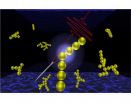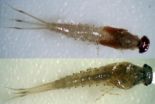(Press-News.org) Over the years, many adolescents have been forced to accept the diagnosis "growing pains" when they complained about pain in their knees. A new PhD study involving 3,000 adolescents has now shown that the knee pain often carries on:
"We can see from the study that one in three young people between the ages of 12 and 19 experience problems with pain in their knees. Seven percent of the adolescents experience daily knee pain in the front of the knee," says physiotherapist and PhD Michael Skovdal Rathleff from Aarhus University, and continues:
"More than half still have problems after two years, so it is not something they necessarily grow out of."
Poorer quality of life
The study thus suggests that knee pain is a bigger problem than previously assumed. According to the researcher there are several good reasons to take knee pain more seriously in the future:
"If knee pain is not treated there is a high risk of the pain becoming chronic. And this clearly has a big consequence for the individual's everyday life and opportunities. In fact, our findings show that these adolescents have as much pain symptoms and reduced quality of life as adolescents on a waiting list for a cruciate knee ligament reconstruction, or as a 75-year-old six months after receiving a new knee.
"Secondly, we can see that this group of adolescents often stop doing sport because of the knee pain. This is, of course, extremely unfortunate, because we know that it is very difficult to start again once you have stopped," says Michael Skovdal Rathleff.
Other surveys show that approximately one third of adult Danes suffer from pain in their knees, and also that approximately 25 percent of the patients who have received new knees due to osteoarthritis of the kneecap also state that they have suffered from knee pain since adolescence. This suggests that osteoarthritis of the kneecap can in some cases begin with knee pain during adolescence.
Need for earlier treatment
According to Michael Skovdal Rathleff, the good news is that the pain disappears with the right training in the case of up to half of the young people. However, it can be a challenge to fit such training into the daily life of an adolescent. And an early effort is important:
"It is worrying that the pain only disappears in the case of half of the young people who actually do the training. The indications are that we should start the treatment somewhat earlier where it is easier to cure the pain. Though this does not necessarily mean that all adolescents with bad knees must visit a physiotherapist. A closer cooperation between physiotherapists and general practitioners about how to best help these young people could also be a solution," concludes Michael Skovdal Rathleff.
The project's findings have been published in the recognised scientific journal BMC Pediatrics.
INFORMATION:
Facts about the study
3,000 adolescents took part in a preliminary questionnaire-based survey in 2011.
Aged 12-19 they were pupils at primary and upper secondary schools in Aalborg Municipality.
504 adolescents between the ages of 15 and 19 stated that they suffered from knee pain and were subsequently followed in the study.
153 of them were diagnosed with Patellofemoral Pain Syndrome (PFP), which is the most common and most serious knee diagnosis.
55 percent of the adolescents with PFP still suffered from knee pain after two years.
On 16 June 2014, Michael Skovdal Rathleff defended his PhD on the subject.
Contact
Physiotherapist and PhD student Michael Skovdal Rathleff
Aarhus University, Department of Clinical Medicine and
Aalborg University Hospital, Department of Occupational Therapy and Physiotherapy
Tel.: +45 2211 7002 / +45 9932 1111
msr@clin.au.dk / misr@rn.dk
Many people never grow out of their growing pains
A new research project from Aarhus University shows that many adolescents suffer from knee pain for several years; the pain impacts both sporting activities and quality of life
2014-07-28
ELSE PRESS RELEASES FROM THIS DATE:
Glow in space is evidence of a hot bubble in our galaxy
2014-07-28
VIDEO:
Dr. Massimilano Galeazzi discusses his work on a sounding rocket, sent into the atmosphere to search for answers about the universe.
Click here for more information.
CORAL GABLES, Fla. (July 27, 2014) — When we look up to the heavens on a clear night, we see an immense dark sky with uncountable stars. With a small telescope we can also see galaxies, nebulae, and the disks of planets. If you look at the sky with an X-ray detector, you would see many of these same familiar ...
Interfering with interferon
2014-07-28
Using the body's natural virus killers to prevent and treat HIV infection has been problematic until now because of the strong inflammatory response these molecules can arouse as they get rid of the invaders. Now, collaborative research conducted by scientists at the Weizmann Institute and the National Institutes of Health (NIH) have demonstrated how suppressing the activity of these molecules – interferons – around the time of infection could have long-term implications for the course of the disease. Their research appeared in Nature.
Interferons, named for their ability ...
Industrial lead pollution beat explorers to the South Pole by 22 years and persists today
2014-07-28
RENO – Norwegian explorer Roald Amundsen became the first man to reach the South Pole in December of 1911. More than 100 years later, an international team of scientists led by Joe McConnell of Nevada's Desert Research Institute (DRI) have proven that air pollution from industrial activities arrived long before.
Using data from 16 ice cores collected from widely spaced locations around the Antarctic continent, including the South Pole, McConnell's team created the most accurate and precise reconstruction to date of lead pollution over the Earth's southernmost continent. ...
Building 'invisible' materials with light
2014-07-28
A new method of building materials using light, developed by researchers at the University of Cambridge, could one day enable technologies that are often considered the realm of science fiction, such as invisibility cloaks and cloaking devices.
Although cloaked starships won't be a reality for quite some time, the technique which researchers have developed for constructing materials with building blocks a few billionths of a metre across can be used to control the way that light flies through them, and works on large chunks all at once. Details are published today (28 ...
Superconductivity could form at high temperatures in layered 2D crystals
2014-07-28
An elusive state of matter called superconductivity could be realized in stacks of sheetlike crystals just a few atoms thick, a trio of physicists has determined.
Superconductivity, the flow of electrical current without resistance, is usually found in materials chilled to the most frigid temperatures, which is impractical for most applications. It's been observed at higher temperatures–higher being about 100 kelvin or minus 280 degrees below zero Fahrenheit–in copper oxide materials called cuprate superconductors. But those materials are brittle and unsuitable for fabricating ...
Lifestyle choices may affect the long-term heart health of childhood cancer survivors
2014-07-28
A new study has found that following a healthy lifestyle may lower childhood cancer survivors' risk of developing the metabolic syndrome. Published early online in CANCER, a peer-reviewed journal of the American Cancer Society, the findings indicate that children with cancer and adults who had cancer when they were children should receive information about how their lifestyle may influence their long-term health.
Adults who had cancer as children are known to be at increased risk for the metabolic syndrome, a group of risk factors that increases the likelihood of developing ...
Nicotine found to inhibit DNA-strand break caused by a certain carcinogen in smoke
2014-07-28
A new in vitro study has revealed that nicotine and cotinine, a metabolite of nicotine, can potentially inhibit DNA damage caused by a certain carcinogen in smoke.
The carcinogen 4-(methylnitrosamino)-1-(3-pyridyl)-1-butanone or NNK is produced during the curing of tobacco leaves and ultimately ends up in the tobacco smoke. Once inhaled, it is metabolised in the lung and liver, where it is activated by a variety of enzymes called Cytochrome P450 (CYP). Previous research in mice has revealed that nicotine can partially interfere with the activation of NNK, and this has ...
Dinosaurs fell victim to perfect storm of events, study shows
2014-07-28
Dinosaurs might have survived the asteroid strike that wiped them out if it had taken place slightly earlier or later in history, scientists say.
A fresh study using up-to-date fossil records and improved analytical tools has helped palaeontologists to build a new narrative of the prehistoric creatures' demise, some 66 million years ago.
They found that in the few million years before a 10km-wide asteroid struck what is now Mexico, Earth was experiencing environmental upheaval. This included extensive volcanic activity, changing sea levels and varying temperatures. ...
Hepatitis C virus genotype 1 is most prevalent worldwide
2014-07-28
In one of the largest prevalence studies to date, researchers from the U.K. provide national, regional, and global genotype prevalence estimates for the hepatitis C virus (HCV). Findings published in Hepatology, a journal of the American Association for the Study of Liver Diseases, indicate that genotype 1 is the most prevalent worldwide, with over 83 million patients infected of which one-third reside in East Asia. Genotype 3, at just over 54 million cases, is the next most prevalent, followed by genotypes 2, 4, 6, and 5.
Despite efforts to control HCV, it remains one ...
New species of mayfly discovered in India
2014-07-28
Scientists have discovered a new species of mayfly in the southern Western Ghats, a mountain range along the west coast of India. In fact, this is the first time that any mayfly belonging to the genus Labiobaetis has been collected in peninsular India.
The new species, called Labiobaetis soldani, "is named in honor of Dr. T. Soldan for his substantial contribution to the understanding of the Ephemeroptera of Palaearctic and Oriental realms," according to the authors of a study that describes the new mayfly in the Journal of Insect Science.
The larvae have light-brown ...
LAST 30 PRESS RELEASES:
Making lighter work of calculating fluid and heat flow
Normalizing blood sugar can halve heart attack risk
Lowering blood sugar cuts heart attack risk in people with prediabetes
Study links genetic variants to risk of blinding eye disease in premature infants
Non-opioid ‘pain sponge’ therapy halts cartilage degeneration and relieves chronic pain
AI can pick up cultural values by mimicking how kids learn
China’s ecological redlines offer fast track to 30 x 30 global conservation goal
Invisible indoor threats: emerging household contaminants and their growing risks to human health
Adding antibody treatment to chemo boosts outcomes for children with rare cancer
Germline pathogenic variants among women without a history of breast cancer
Tanning beds triple melanoma risk, potentially causing broad DNA damage
Unique bond identified as key to viral infection speed
Indoor tanning makes youthful skin much older on a genetic level
Mouse model sheds new light on the causes and potential solutions to human GI problems linked to muscular dystrophy
The Journal of Nuclear Medicine ahead-of-print tip sheet: December 12, 2025
Smarter tools for peering into the microscopic world
Applications open for funding to conduct research in the Kinsey Institute archives
Global measure underestimates the severity of food insecurity
Child survivors of critical illness are missing out on timely follow up care
Risk-based vs annual breast cancer screening / the WISDOM randomized clinical trial
University of Toronto launches Electric Vehicle Innovation Ontario to accelerate advanced EV technologies and build Canada’s innovation advantage
Early relapse predicts poor outcomes in aggressive blood cancer
American College of Lifestyle Medicine applauds two CMS models aligned with lifestyle medicine practice and reimbursement
Clinical trial finds cannabis use not a barrier to quitting nicotine vaping
Supplemental nutrition assistance program policies and food insecurity
Switching immune cells to “night mode” could limit damage after a heart attack, study suggests
URI-based Global RIghts Project report spotlights continued troubling trends in worldwide inhumane treatment
Neutrophils are less aggressive at night, explaining why nighttime heart attacks cause less damage than daytime events
Menopausal hormone therapy may not pose breast cancer risk for women with BRCA mutations
Mobile health tool may improve quality of life for adolescent and young adult breast cancer survivors
[Press-News.org] Many people never grow out of their growing painsA new research project from Aarhus University shows that many adolescents suffer from knee pain for several years; the pain impacts both sporting activities and quality of life





